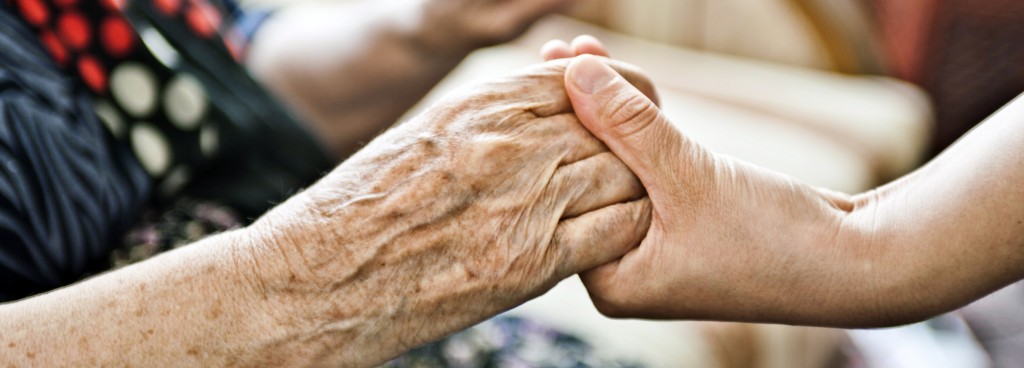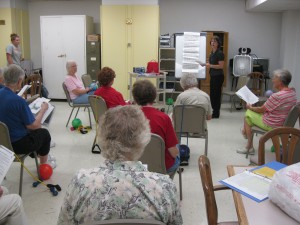By Maggie Silver
When the Cedar River flood waters began to rise in Iowa most residents were able to see the impending danger and safely evacuate their homes. But Donna, an elderly woman living in a secluded section of town is blind, and couldn’t see when her basement began to fill with water. Since she doesn’t watch TV she didn’t see or hear the warnings on the local news. When the police and fire department came out to her flooded house to rescue her she was suspicious of the men knocking on the door telling her she needed to leave.
It wasn’t until Janna Diehl, from the Hawkeye Valley Area Agency on Aging, came to talk to her that Donna realized she was in danger and needed to go. Donna was safely taken to an assisted living facility away from the threatening flood waters where she lived for a month until the damage to her home could be assessed. With the help of staff at assisted living facility Donna was able to apply for FEMA relief funds to pay for alternate housing after her home was deemed uninhabitable. Not being able to return to her home was unsettling to Donna who had already been through so much, she didn’t trust family members who wanted her to move into a FEMA trailer, but she still wanted to maintain her independence and didn’t want to stay at the assisted living facility. With Diehl’s help, Donna was able to find a duplex in a retirement community that offered her the independence she wanted, but the support of a tight-knit community should something happen.
Donna’s case is not unusual. Older adults face many more obstacles during an emergency than most people. Isolation, limited mobility, medical needs, and distrust are just a few of the factors that emergency planners must consider when responding to a disaster. Diehl works with local first responders and emergency management groups to educate them on the needs of older adults. She takes part in local exercises to test emergency plans, pretending to be the older clients she serves.
“Often times they don’t think about what they will do with people who can’t stand for hours waiting in line for food or medicine at shelters. They don’t think about what they’ll do when one of my clients refuses to go anywhere without Fluffy,” explains Diehl.
So what is Diehl’s biggest tip for helping keep older adults safe in the face of danger? Simple, be neighborly. If you have an elderly person living on your street or in your apartment complex check on them when the power goes out or when forecasters are calling for a big storm. Diehl and her husband go knocking on doors in their neighborhood before big snow storms to see if their older neighbors need anything from the grocery store. It just takes a simple act that could make all the difference.
If you have family members who are older, talk to them about what they would do in the event of a flood, power outage, or other emergency. Make sure they have a “go-bag” that includes a list of their medications and doctor’s name. Diehl mentions that often older adults don’t know their doctor’s full name, they just know them by ‘Doctor John,’ and in an emergency this can pose a serious problem. Make sure you talk to your elderly relative and other family members about where your loved one would go if they needed to leave their home and who would take them there.
September is National Preparedness Month, and during this time we encourage you to talk to your elderly neighbors and family members to make sure they have a plan in case of an emergency, big or small.
You can get more information about older adults and emergency planning here: http://www.cdc.gov/aging/emergency/




Public Comments
Comments listed below are posted by individuals not associated with CDC, unless otherwise stated. These comments do not represent the official views of CDC, and CDC does not guarantee that any information posted by individuals on this blog is correct, and disclaims any liability for any loss or damage resulting from reliance on any such information. Read more about our comment policy ».
September 5, 2012 at 6:08 pm ET - Dan Wood, PIO, Medical Board of California
Your article is informative. As a journalist in California for nearly 30 years, I covered my share of disasters. One your article brings to mind is the Northridge earthquake that hit Los Angeles years ago. On my third day covering the quake, I came across a woman in her 80′s. She was barefoot and in a nightgown and shaking. She had spent two nights on the street dressed as she was when the predawn quake hit two days earlier. No food, no medicine and just lucky to be alive. I was trying to get someone to help her find a shelter or aid center when her son, who thought she had been killed, showed up. The sight brought tears to my eyes. I realized then how important prepardness and planning are. She was one of the lucky ones, she had someone looking for her. What about those who dont? Think about it.
Link to this comment
September 5, 2012 at 10:26 pm ET - Ellen Blackwell
Let’s also remember people with disabilities living in neighborhood settings, who may have even fewer connections with neighbors and others if they live in group homes and do not have family nearby. Being a good neighbor is about thinking about everyone in your neighborhood, especially those you may not know, in times of need. You may make some new friends in the process and it feels great to reach out this way!
Link to this comment
September 6, 2012 at 8:17 am ET - patricia adamcak
Will medicare and private insurance companies allow for ( pay) presciptions to be obtained for the purposes of a go-bag?
Link to this comment
September 6, 2012 at 11:02 am ET - catherine Anderer RN, BSN
thank you for all of this great information. Senior citizens are very uninformed and vulnerable in these situations. I would love to give classes at libraries and senior citizen centers. As a nurse working in the community, i feel it wou be a great way to educate the general public, seniors and caregivers. Any suggestions? Does the CDC give grants or help educate the communty? I am a willing seasoned nurse who would thrive on educating people that cannot get this information or do not know it is even available.
Link to this comment
September 7, 2012 at 8:47 am ET - Janna Diehl
No they will probably not cover it but something that could be included in the ‘to go bag’ would be a print out from the pharmacy(ies) on what presecriptions are being taken and the name of the doctor and contact information.
Link to this comment
September 7, 2012 at 8:50 am ET - Janna Diehl
Here in Iowa, we educate through our area agencies on aging. I have had great success in meeting with all types of groups talking about preparedness.
Link to this comment
AUTHOR COMMENT September 10, 2012 at 8:22 am ET - Blog Administrator
@CatherineAnderer, You can try contacting your local health department or your Area Agency on Aging, to see if they have toolkits that are being used in your community (there are lots of good examples – see http://www.cdc.gov/aging/emergency/training.htm – the bottom two on the page are good resources – Red Cross and Mather Lifeways) Or, the personal prep page: http://www.cdc.gov/aging/emergency/preparedness.htm
Good luck!
Link to this comment